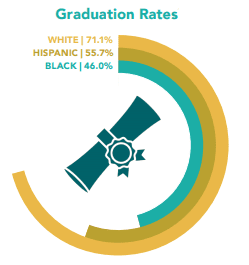101: Public Awareness: Racial Disparities in Higher Education
Public Awareness
 A national survey conducted by Higher Learning Advocates suggests that the public lacks awareness of achievement gaps in postsecondary education. When asked whether Hispanic and Black college students attending four-year public institutions were less likely to complete their degree than their white peers, a majority (51%) of survey respondents answered “no.” The truth is that students of color graduate at rates 15 to 25 percentage points lower than white students.
A national survey conducted by Higher Learning Advocates suggests that the public lacks awareness of achievement gaps in postsecondary education. When asked whether Hispanic and Black college students attending four-year public institutions were less likely to complete their degree than their white peers, a majority (51%) of survey respondents answered “no.” The truth is that students of color graduate at rates 15 to 25 percentage points lower than white students.
The national survey also found that less than half (47%) of Americans are aware that Hispanic and Black college students are less likely to complete their degree than their white peers. One hundred percent of “insiders,” in contrast, were able to correctly identify that students of color are less likely to complete their degree than their white peers. Respondents with a bachelor’s degree (62%) were most likely to answer correctly, and respondents 65 and older were least likely to answer correctly.
Like many of today’s students, students of color often struggle to access and complete their postsecondary degree due to financial barriers, family obligations, lack of student support services, work obligations, and other challenges; therefore, students of color continue to have poorer student outcomes compared to their white peers. Federal policies must work to address these gaps that persist in higher education.
This Higher Education 101 highlights the public’s lack of awareness of achievement gaps in postsecondary education.
